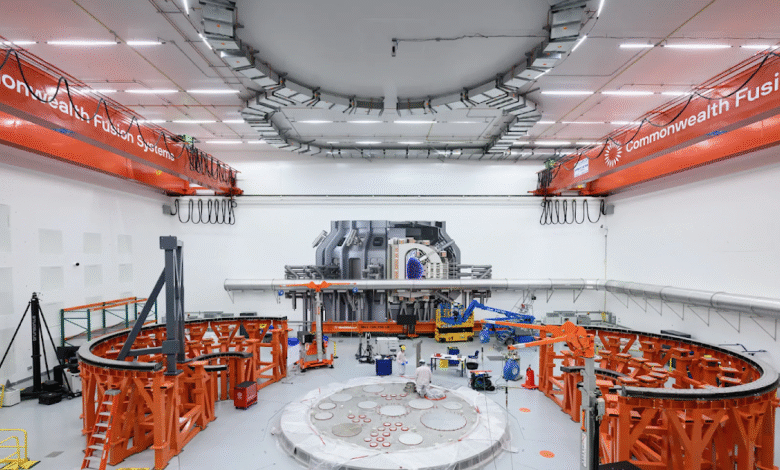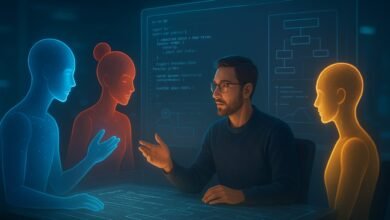Bringing AI to the next generation of fusion energy

sciences
We partner with Commonwealth Fusion Systems (CFS) to bring clean, safe, unlimited fusion energy closer to reality.
Fusion, the process that powers the sun, promises clean, abundant energy without long-lived radioactive waste. Making it work here on Earth means keeping ionized gas, known as plasma, stable at temperatures of more than 100 million degrees Celsius — all within the limits of a fusion energy machine. This is a very complex physics problem and we are working to solve it using artificial intelligence (AI).
Today we announce our research partnership with Commonwealth Fusion Systems (CFS), a global leader in fusion energy. CFS is pioneering a faster path to clean, safe and effectively unlimited fusion energy with its compact and powerful tokamak machine called SPARC.
SPARC makes use of powerful, high-temperature superconducting magnets and aims to be the first magnetic fusion machine in history to generate net fusion energy—energy from fusion greater than what is needed to sustain it. This landmark achievement is known as the “break-even point,” and is a critical milestone on the path to viable fusion energy.
This partnership builds on our pioneering work using artificial intelligence to successfully control plasma. With academic partners at the Swiss Plasma Center at EPFL (École Polytechnique Fédérale de Lausanne), we have shown that deep reinforcement learning can control tokamak magnets to stabilize complex plasma shapes. To cover a broader range of physics, we have developed TORAX, a fast and differentiated plasma simulator written in JAX.
Now, we are taking this work to the CFS to accelerate the timeline for delivering fusion energy to the grid. We have cooperated in three main areas so far:
- Produce fast, accurate and differentiated simulations of fusion plasma.
- Find the most efficient and powerful path to maximize fusion energy.
- Using reinforcement learning to discover new control strategies in real time.
The combination of our AI expertise and cutting-edge CFS hardware makes this the ideal partnership to advance fundamental discoveries in fusion energy for the benefit of the global research community and, ultimately, the entire world.
Fusion plasma simulation
To improve the performance of a tokamak, we need to simulate how heat, electric current and matter flow through the plasma core and interact with the systems around it. Last year, we released TORAX, an open source plasma simulator designed to optimize, control, and expand the range of physics questions we can address beyond magnetic simulations. Built in JAX, TORAX can easily run on both CPUs and GPUs and can seamlessly integrate AI-powered models, including our own, for better performance.
TORAX will help CFS teams test and improve their operating plans by running millions of virtual experiments before running SPARC. It also gives them the flexibility to quickly adapt their plans as soon as the first data arrives.
This software has become a staple in CFS’s daily workflow, helping them understand how plasma behaves under different conditions, saving valuable time and resources.
“
TORAX is a professional, open source plasma simulator that has saved us countless hours setting up and running our own simulation environments for SPARC.
Devon Battaglia, senior director of physics operations at CFS
Find the fastest way to get maximum power
Operating a tokamak involves countless options in how to adjust the various “knobs” available, such as magnetic coil currents, fuel injection, and heating power. Manually finding the ideal settings for a tokamak to produce the most power, while staying within operating limits, can be very inefficient.
Using TORAX with reinforcement learning or evolutionary heuristics like AlphaEvolve, our AI agents can explore a large number of potential operating scenarios in simulation, and quickly identify the most efficient and robust paths to net energy generation. This can help CFS to focus on the most promising strategies, increasing the likelihood of success from day one, even before SPARC is fully up and running at full capacity.
We have built the infrastructure to investigate different SPARC scenarios. We can look at maximizing the strength of the fusion produced under different constraints, or improving robustness as we learn more about the machine.
Here we show examples of a standard SPARC pulse simulated in TORAX. Our AI system can evaluate many potential pulses to find the settings that we expect will deliver the best performance.
Cross-section visualizations through SPARC. Left: Fuchsia plasma. Right: Example of a plasma pulse simulated in TORAX, showing changes in plasma pressure. Far right: We show that adjusting the control commands changes the plasma performance, resulting in different plasma pulsations.
Through our growing network of collaborations within the fusion research community, we will be able to validate and calibrate TORAX against previous tokamak data and high-resolution simulations. This information will provide confidence in the accuracy of the simulation and will help us adapt quickly once SPARC begins operations.
Develop an AI pilot program for real-time control
In our previous work, we showed that reinforcement learning can control the magnetic configuration of tokamaks. We are now increasing the complexity by adding simultaneous optimization of more aspects of tokamak performance, such as maximizing fusion power or managing SPARC heat load, so that it can operate at high performance with a greater margin for machine limits.
When operating at full power, SPARC will emit tremendous heat focused on a small area that must be carefully managed to protect the solids closest to the plasma. One strategy SPARC can use is to magnetically scan the exhaust energy along the wall, as shown below.
Left: The location of the material facing the plasma is shown on the right side of the SPARC interior. Right: 3D animation of the rate of energy deposition on materials facing the plasma, as the plasma composition changes (not representing the actual pulse in SPARC). Image provided using HEAT (https://github.com/plasmapotential/HEAT), courtesy of Tom Looby at CFS.
In the initial phase of our collaboration, we are studying how reinforcement learning agents can learn to dynamically control plasma to effectively distribute this heat. In the future, AI could learn more complex adaptive strategies than anything an engineer might create, especially when balancing multiple constraints and goals. We can also use reinforcement learning to quickly adjust conventional control algorithms to a given pulse. The combination of pulse optimization and optimal control could push SPARC further and faster to achieve its historic goals.
Unifying AI and fusion to build a cleaner future
Alongside our research, Google has invested in CFS, supporting its work on promising scientific and engineering breakthroughs, and moving its technology toward commercialization.
Looking to the future, our vision extends beyond improving SPARC operations. We are building the foundations of AI to become an intelligent, adaptive system at the heart of future fusion power plants. This is just the beginning of our journey together, and we hope to share more details about our collaboration as we reach new milestones.
By uniting the revolutionary potential of artificial intelligence and fusion, we are building a cleaner, more sustainable energy future.
Thanks and appreciation
This work is a collaboration between Google DeepMind and Commonwealth Fusion Systems.
Google Deepmind contributors: David Pfau, Sarah Bechtel, Sebastian Bodenstein, Jonathan Citrin, Ian Davies, Bart de Velder, Craig Donner, Tom Eccles, Federico Felici, Anushan Fernando, Ian Goodfellow, Philip Hamel, Andrea Huber, Tyler Jackson, Amy Nomiuts Sleep, Tamara Norman, Ochichi. Okereke, Francesca Pietra, Akhil Raju, and Brendan Tracy.
Commonwealth Integration Systems contributors: Devon Battaglia, Tom Boddy, Dan Boyer, Alex Creeley, Jaydeep Deshpande, Christoph Haas, Peter Kaloyannis, Will Koch, Tom Luby, Matthew Reinke, Josh Sulkin, Anna Teblokhina, Misha Veldhoen, Josiah Way, and Chris Woodall.
We would also like to thank Pushmeet Kohli and Bob Mumgaard for their support.
Credits: The SPARC facility image, SPARC renderings, and CAD rendering of the transformer tiles are Copyright 2025 Commonwealth Fusion Systems.
Don’t miss more hot News like this! Click here to discover the latest in AI news!
2025-10-16 13:00:00




